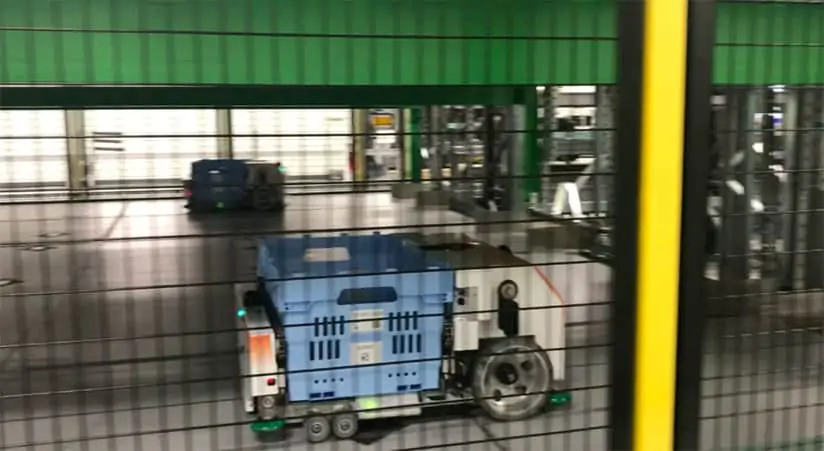If spending your precious free time in a grocery store is not your idea of fun, Walmart (WMT) may have the solution for you. Walmart, the world’s largest seller of groceries, has begun piloting a robotic based system for picking groceries for its fast-growing online grocery pickup. The retailer has partnered with Masschusetts-based Alert Innovation to deploy Alphabot at a supercenter store in Salem, New Hampshire. The Alphabot system combines novel approaches to robots, racking structures, picking workstations, and control software to pick grocery orders with incredibly fast turnaround times. Prior to committing to piloting this technology, Walmart relied on simulation modeling provided by MOSIMTEC to understand the feasibility of this technology.
The following YouTube video is from the AnyLogic 2019 conference and provides a video version of the case study below.
System Description
As described in a recent Yahoo Finance article:
Alphabot automates specific steps of the online grocery pickup process by using autonomous mobile carts to gather shelf-stable, refriger
ated, and frozen items from a high-density storage system. Alphabot’s robotic carts retrieve and deliver these items to store associates to quickly fulfill online orders. What’s more, all of this
happens at the back of the store, out of the view of customers.
Alphabot is supposed to make the job of the customer and the associate easier. Its aim is to allow associates to complete more orders faster than they would by simply walking up and down the aisles in search of goods. It also frees up time for associates to carefully select fresh produce and meat while the robots do the other work behind the scenes. For the customer, it saves time and keeps prices low. This technology is a step up from Automated Guided Vehicles (AGV), in use across warehouses and factories, because they do not need to travel on pre-programmed pathways.
Use of simulation for product feasibility analysis
MOSIMTEC developed the initial computer simulation model to assist Walmart in making an investment decision on the new Alphabot technology, while it was still in an early design phase. The model was used to test the service-level capabilities in a variety of customer demand situations, along with identifying improvement opportunities.
The goal of the simulation was to help Walmart and Alert understand throughput and turnaround time capabilities of the Alphabot system during peak customer demand periods for ambient and frozen products. MOSIMTEC also analyzed the system under unconstrained demand conditions to benchmark the limits of the system. The model enabled Walmart to identify the best configuration of the racking structure, automated bots and each-picking workstations required at a variety of store profiles. The outputs from the model informed the business case for deploying Alphabot across various stores in Walmart’s retail network.
After completing the independent analysis of system capabilities, the AnyLogic simulation model was transitioned to Alert for long-term use in fine-tuning software control algorithms for eventual production deployment. This is a classic example of utilizing simulation models across multiple design phases. In this case, the model provided continued benefit after the initial feasibility analysis that was the focus of the modeling engagement.
This model can be used for on-going operational purposes, by being a tool to correctly size future stores that adopt the Alphabot technology. In addition to Alert using the model for additional detailed design, Walmart also continued to use the model to further explore the best use cases for the Alphabot technology.
Benefits
The outputs from the simulation model were critical in developing the business case for Walmart to invest in the Alphabot technology. Through simulation, Walmart was able to understand the strengths and weaknesses of Alphabot in a variety of situations. Walmart could then compare the performance of Alert’s Alphabot with other industry leading Automated Storage and Retrieval Systems (ASRS) and Goods-to-Person (GTP) technologies. Simulation modeling provides richer insights, by giving a sense of the probability of success and quantifying risk. Considering the random variability in a system, along with understanding how sensitive the system is to certain factors, simulation modeling provides much more robust insights than a static spreadsheet calculation that relies on historical or predicted averages.
An example of these robust metrics, which go beyond static averages, is described in the recent Yahoo Finance article:
The computer simulations look promising, though, with results indicating that 95% of orders can get picked in less than 8 minutes, with an average pick time of 3 and 4 minutes.
With simulation, organizations can quantity the cost-benefit of various service levels. For example, companies often find labor and capital expense grow exponentially when reaching a few outlier customers. Percentile-based outputs, common with computer simulation models, allows decision makers to understand the true cost of setting various performance targets. Not only does the simulation model provide percentile based outputs and ranges, but it also does so with a much higher degree of confidence than dealing with basic formulas in a spreadsheet.
In addition to answering the immediate question of whether Walmart should move forward with the Alphabot technology, the simulation engagement provided valuable insights into the system design itself. This allowed Alert Innovation to know which areas would require the greatest focus when they begin to take the system into detailed design phases. Another key benefit of the simulation engagement was that the delivered simulation tool can be used for future design questions and tactical operational decisions.
About MOSIMTEC
The MOSIMTEC concept is different from traditional engineering and consulting services. It is based on the paradigm that technology will be instrumental in decision making. Sophisticated computer simulation software in combination with ever increasing processing speed and memory will enable decision support tools to deliver deep insight in a complex, dynamic, and real-time world. The MOSIMTEC team has extensive experience working with leading computer simulation software and solving complex issues for clients across various industries. We are uniquely positioned to support clients in making smart decisions by applying Modeling & Simulation Engineering (MSE) to predict outcomes, prescribe actions and improve operations.
